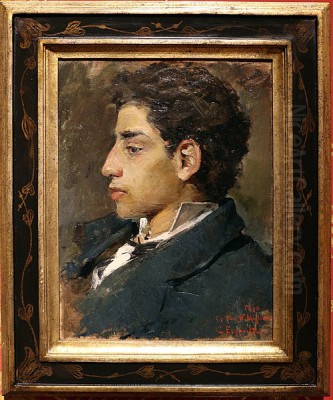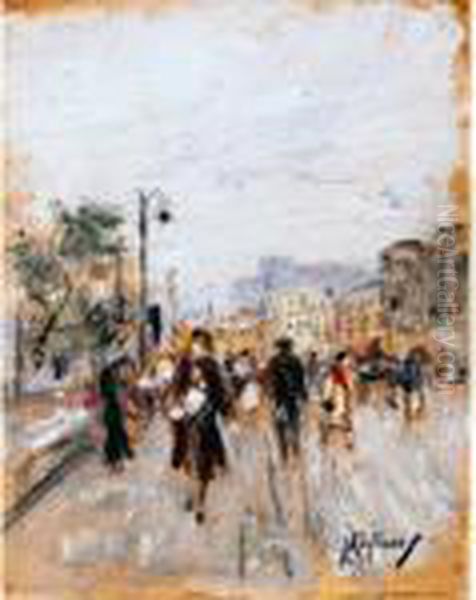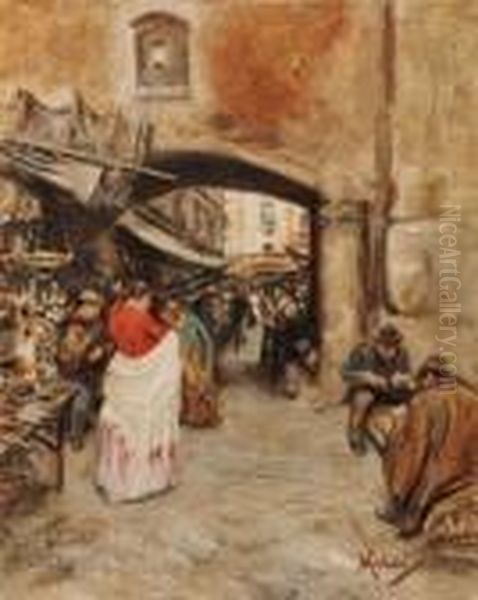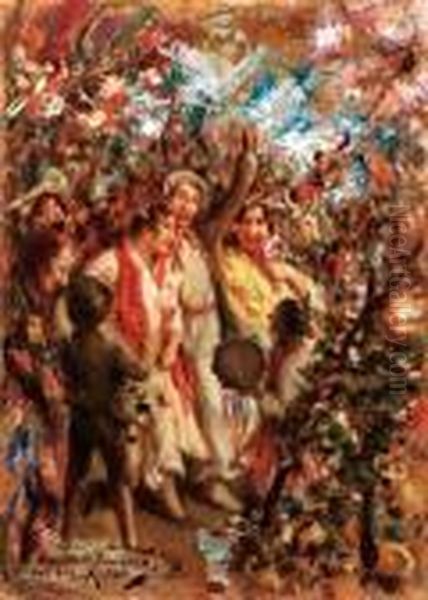
Vincenzo Migliaro stands as a significant figure in Italian art history, particularly renowned for his vibrant and insightful depictions of life in his native Naples during the late 19th and early 20th centuries. Born in Naples in 1858 and passing away there in 1938, Migliaro's artistic journey was deeply intertwined with the city he so meticulously observed and painted. Associated with the Impressionist movement, his style nonetheless retained a unique character, deeply rooted in the traditions of Neapolitan realism and focused on capturing the specific atmosphere and social fabric of the bustling port city.
Migliaro's work offers a window into the Naples of his time, showcasing its crowded markets, lively streets, festive celebrations, and the everyday moments of its inhabitants. He possessed a remarkable ability to translate the energy, colour, and human drama of the city onto canvas, making him not just a painter, but a visual chronicler of an era. His legacy is that of an artist dedicated to his environment, technically skilled, and emotionally resonant in his portrayals.
Early Life and Artistic Formation
Vincenzo Migliaro's artistic inclinations emerged early in his life. Born into the vibrant environment of Naples, he initially received training in practical crafts, specifically wood carving. This foundational experience likely honed his observational skills and dexterity, providing a solid base for his future artistic endeavours. His formal art education began in earnest when, at the young age of fifteen, he enrolled in the prestigious Naples Institute of Fine Arts (Istituto di Belle Arti di Napoli, now the Accademia di Belle Arti di Napoli) in 1875.
The Academy in Naples was a crucible of artistic talent and rigorous training during this period. Migliaro had the invaluable opportunity to study under influential masters, most notably Domenico Morelli. Morelli was a leading figure in Neapolitan painting, known for his historical subjects, dramatic compositions, and increasingly experimental use of colour and light, which moved away from strict academicism towards a more realistic and emotionally charged style. Studying under Morelli undoubtedly shaped Migliaro's technical abilities and artistic outlook.

Migliaro quickly demonstrated his promise. In 1877, while still a student, he participated in a national competition organized by the Italian Ministry of Public Education. His talent was recognized when he secured second place for his painting titled La testa della donna (Woman's Head). This early success marked him as a rising talent within the competitive Neapolitan art scene and affirmed his decision to pursue a career as a painter. His versatility was also apparent early on, as he explored not only painting but also sculpture, etching, and watercolour.
Artistic Style and Influences
Vincenzo Migliaro's artistic style is often categorized within the broad spectrum of Italian Impressionism, yet it possesses distinct characteristics that set him apart. While he embraced the Impressionist interest in capturing light, colour, and contemporary life, his approach was deeply filtered through the lens of Neapolitan realism, often referred to as Verismo. Unlike French Impressionists who often focused on the fleeting effects of light and atmosphere in landscapes or bourgeois leisure, Migliaro's primary focus remained the bustling, often gritty, reality of Naples' urban environment.
His training under Domenico Morelli provided a strong foundation in drawing and composition, but Morelli's later, more experimental phase also encouraged an exploration of colour and a move towards greater realism. Migliaro absorbed these lessons, developing a keen eye for detail and a remarkable ability to render the textures and specifics of Neapolitan life. His brushwork could be lively and suggestive, particularly in capturing crowds and movement, but often retained a solidity and descriptive clarity rooted in realist traditions.
A significant influence on Migliaro's development was a trip to Paris. Exposure to the masterpieces in the Louvre and the contemporary art scene, including the works of French Impressionists like Pierre-Auguste Renoir, likely broadened his artistic horizons. While he didn't fully adopt the French Impressionist technique, the Parisian experience may have reinforced his interest in vibrant colour palettes, the play of light, and the depiction of modern urban subjects. However, he always adapted these influences to his own temperament and his unwavering dedication to Neapolitan themes.
Migliaro was a multi-talented artist, proficient not only in oil painting but also in sculpture, modelling, etching, and watercolour. This diverse skill set perhaps contributed to the richness of his vision, allowing him to think about form and composition in multiple dimensions. His sculptures, though less known than his paintings, further demonstrate his technical mastery and understanding of human anatomy and expression.
Key Themes and Subjects

The heart and soul of Vincenzo Migliaro's oeuvre is the city of Naples itself. He was a painter of urban life, fascinated by the daily theatre unfolding on its streets, in its markets, and during its celebrations. His works are populated by the ordinary people of Naples – vendors, shoppers, fishermen, families, musicians – captured in their natural element. He avoided idealization, instead focusing on the authentic character and energy of his subjects and their surroundings.
Markets were a recurring and favourite theme for Migliaro. Paintings like Mercato a Napoli (Market in Naples) exemplify his ability to depict the vibrant chaos and social interaction of these central hubs of city life. He captured the colourful displays of produce, the animated gestures of buyers and sellers, and the overall sensory richness of the market atmosphere. His keen observation allowed him to render not just the scene, but the feeling of being immersed within it.
The streets and squares of Naples provided another constant source of inspiration. Works such as Passeggiata a Napoli (Walk in Naples) or Piazza Francese depict the flow of daily life against the backdrop of the city's distinctive architecture. He captured moments of leisure, work, and transit, often focusing on the interplay of figures within the urban space. His paintings convey the unique light of Southern Italy, whether it's the bright Mediterranean sun casting sharp shadows or the soft glow of twilight or moonlight, as seen in A clair de lune.
Festivals and popular celebrations offered Migliaro opportunities to depict Neapolitan culture at its most exuberant. His Festa di Piedigrotta captures the famous annual festival known for its music, processions, and revelry. These works are often characterized by dynamic compositions, a multitude of figures, and a heightened sense of energy and colour, reflecting the collective spirit of the event. Works like Un giorno di festa (A Holiday) similarly explore moments of communal celebration and leisure.
Beyond the bustling public scenes, Migliaro also produced portraits and studies of individuals, such as the award-winning La testa della donna. These works demonstrate his skill in capturing psychological depth and individual character, complementing his broader focus on the social landscape of Naples. Landscapes, like views of Sorrento, also feature in his work, showcasing his ability to handle different genres while often retaining a focus on the human element within the setting.
Notable Works and Projects

Several specific works stand out in Vincenzo Migliaro's career, representing key moments or characteristic themes. His early success with La testa della donna (1877) immediately established his credentials as a skilled painter capable of sensitive portrayal. This recognition early in his studies was crucial for his burgeoning career.
Among his most celebrated themes are the Neapolitan markets. Mercato a Napoli is perhaps his most iconic work in this vein, frequently appearing in exhibitions and achieving significant prices at auction. These market scenes are prized for their vibrant energy, detailed observation, and masterful handling of crowds and colour, perfectly encapsulating the lively spirit of Naples.
The Festa di Piedigrotta paintings are important representations of Neapolitan popular culture. These works capture the unique atmosphere of this traditional festival, showcasing Migliaro's ability to handle complex, multi-figure compositions filled with movement and excitement. They serve as valuable historical documents of local customs as well as dynamic works of art.
Smaller, more intimate scenes like Passeggiata a Napoli and Un giorno di festa offer glimpses into the everyday rhythms and pleasures of Neapolitan life. Though perhaps less grand in scale than the market or festival scenes, they possess a charm and authenticity that speaks to Migliaro's deep connection with his city and its people. Works depicting specific locations like Piazza Francese or coastal views like Sorrento further demonstrate the breadth of his subject matter within his regional focus.
A significant collaborative project Migliaro participated in was the decoration of the Caffè Gambrinus in Naples. This historic café, a hub for artists and intellectuals, was adorned with works by several prominent Neapolitan painters of the era. Migliaro worked alongside artists such as Vincenzo Caprile and Vincenzo Volpe, contributing to the rich artistic environment of this celebrated establishment. Other artists associated with the Gambrinus decorations or the broader Neapolitan circle included Luca Postiglione, Giuseppe Casciaro, Edoardo Matania, and Nicola Scoppetta, highlighting Migliaro's integration within the city's active art scene.
Context and Contemporaries
Vincenzo Migliaro operated within a rich and dynamic artistic context in Naples and Italy during the late 19th and early 20th centuries. The Neapolitan school of painting had a long and distinguished history, and Migliaro's generation inherited traditions of realism while engaging with newer trends like Impressionism and Verismo. His teacher, Domenico Morelli, was a pivotal figure transitioning from historical painting towards a more modern sensibility.

Migliaro was part of a circle of talented Neapolitan artists who focused on depicting local life and landscapes. Besides his collaborators on the Caffè Gambrinus project like Vincenzo Caprile and Vincenzo Volpe, other notable contemporaries included Attilio Pratella, known for his coastal scenes and cityscapes, and Giuseppe Casciaro, famed for his pastels. Eduardo Dalbono was another significant figure capturing Neapolitan light and life. Artists like Edoardo Matania and Nicola Scoppetta also contributed to the vibrant scene, often sharing similar interests in genre subjects. Luca Postiglione continued the artistic legacy of his family in Naples.
While focused on Naples, Migliaro's work can be situated within the broader Italian art landscape. His realism connects to the Verismo movement, which sought authentic depictions of everyday life, often focusing on regional characteristics. This contrasts somewhat with the Macchiaioli group in Florence (including artists like Giovanni Fattori and Telemaco Signorini), who developed their own revolutionary approach to light and form earlier in the century, but shared a commitment to realism and contemporary subjects. Migliaro’s style also differs from the later Italian Divisionists, like Giovanni Segantini or Giuseppe Pellizza da Volpedo, who employed a more scientific approach to colour.
Internationally, Migliaro's generation contended with the influence of French Impressionism. While Migliaro visited Paris and was likely influenced by artists such as Renoir, his work maintained a distinctly Italian, and specifically Neapolitan, character. He shared the Impressionist interest in modern life and capturing immediate sensations but generally retained a stronger emphasis on drawing, narrative detail, and social observation compared to the optical focus of Monet or Pissarro. Other Italian artists navigated this influence differently; Giuseppe De Nittis, for example, achieved great success in Paris, adopting a more cosmopolitan, elegant style. Antonio Mancini, another Neapolitan contemporary, developed a highly individualistic, thickly impastoed technique that gained international attention.
Comparisons have been drawn between Migliaro and Antonio Morano, another Neapolitan painter depicting city life, suggesting shared thematic concerns within the local school. Migliaro's position was thus firmly rooted in the Neapolitan tradition, engaging with contemporary national and international currents but ultimately forging a personal style dedicated to chronicling his beloved city. His interactions, whether through study, collaboration, or exhibition, placed him firmly within the network of leading Italian artists of his time.
Recognition and Legacy
Throughout his career, Vincenzo Migliaro achieved considerable recognition both within Italy and internationally. His early success in the 1877 national competition was followed by participation in numerous important exhibitions in Naples, Rome, Venice, and other Italian cities. His work was also shown abroad, notably at the International Exposition in Barcelona, where he was awarded a silver medal, attesting to his growing reputation beyond national borders.
His paintings were sought after by collectors and entered various private and public collections. The consistent appearance of his works in auctions, often commanding respectable prices (as noted for Mercato a Napoli), reflects his established market value and the enduring appeal of his subjects and style. His involvement in prestigious projects like the Caffè Gambrinus decorations further solidified his standing within the Neapolitan artistic establishment.
Art historical evaluations acknowledge Migliaro as a key exponent of Neapolitan painting in the period straddling the 19th and 20th centuries. He is praised for his technical skill, his acute powers of observation, and his ability to capture the authentic spirit of Naples. His dedication to local themes – the markets, streets, festivals, and people – makes his work an invaluable visual record of the city's life and culture during a time of significant social and physical transformation.
While some critical commentary, even during his time, occasionally noted a potential repetitiveness or "monotony" in his choice of subjects compared to artists exploring more varied themes, this focus can also be seen as his strength. His deep dive into the Neapolitan world allowed for nuanced and insightful portrayals that might have been lost with a broader focus. His commitment to Verismo, tempered with an impressionistic sensitivity to light and atmosphere, resulted in a body of work that is both documentary and artistically compelling.
Vincenzo Migliaro's legacy lies in his role as a quintessential painter of Naples. He captured the city's vibrant energy, its social dynamics, and its unique cultural identity with honesty and affection. He remains an important figure for understanding Italian art of the period, particularly the rich artistic traditions of Naples, and his works continue to be appreciated for their artistic merit and their evocative portrayal of a bygone era.
Conclusion
Vincenzo Migliaro remains a respected and significant artist within the narrative of Italian art, particularly celebrated for his lifelong dedication to depicting the city of Naples. Emerging from the rigorous training of the Naples Academy under masters like Domenico Morelli, he developed a distinctive style that blended academic solidity, realist observation (Verismo), and an Impressionist sensitivity to colour and light. His extensive body of work, spanning paintings, sculptures, and works on paper, consistently focused on the vibrant life of his native city.
From the bustling energy of its markets and streets to the exuberant celebrations of its festivals and the quiet dignity of its inhabitants, Migliaro captured the essence of Naples with unparalleled authenticity and artistic skill. His participation in major exhibitions, the awards he received, and his collaborative work on projects like the Caffè Gambrinus cemented his position within the Neapolitan and Italian art scenes. While engaging with broader European artistic currents, including French Impressionism, he forged a path deeply rooted in his local environment.
Today, Vincenzo Migliaro is remembered as more than just a painter; he was a visual historian, a chronicler of Neapolitan life whose works offer enduring insights into the city's soul during a pivotal period. His art continues to resonate with viewers through its technical proficiency, its vibrant depiction of everyday reality, and its palpable affection for the city and people it portrays. He holds a secure place as a master of Neapolitan scenes in late 19th and early 20th-century Italian art.